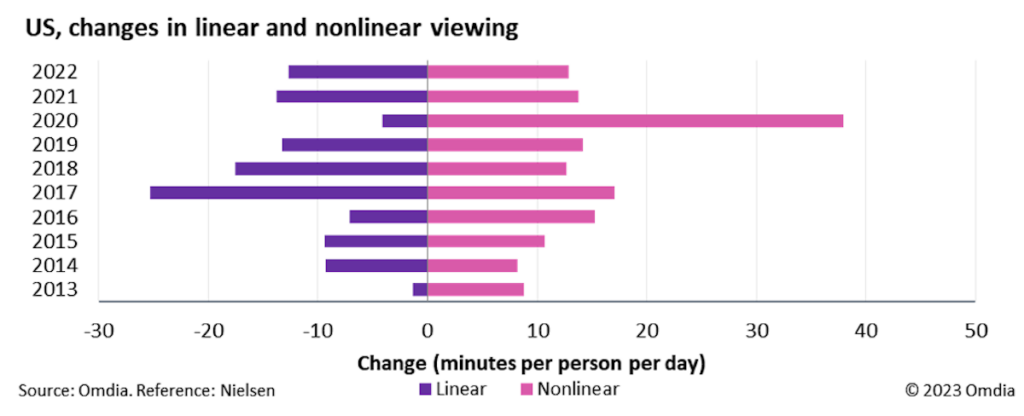
After more than 35 years of operation, TBI is closing its doors and our website will no longer be updated daily. Thank you for all of your support.
TBI Tech & Analysis: How linear’s light is fading amid on demand boom
Viewing habits around the world are changing fast as eyeballs shift from linear programming on TV’s to on demand content online. In an exclusive US-focused excerpt from their latest report, Omdia analysts Rob Moyser, Adam Thomas and Samuel Nkwam explore what’s behind the shift.
Omdia’s annual Cross-Platform Viewing Time Report analyses TV and video consumption trends across the US, Australia, and seven markets in Europe: the UK, France, Germany, Italy, Spain, Sweden, and the Netherlands.
Average total daily viewing time for the markets analysed stood at 373 minutes per person per day in 2022 (6 hours and 13 minutes). When excluding social media video viewing, this total stood at 305 minutes (5 hours and 5 minutes) with viewing time down by 6 minutes on the previous year.
 Linear TV viewing time decreased in all markets in 2022, a fall that was driven by the continual shift toward on-demand viewing and social media viewing.
Linear TV viewing time decreased in all markets in 2022, a fall that was driven by the continual shift toward on-demand viewing and social media viewing.
In terms of overall minutes, Germany (-19.3 minutes) and the Netherlands (-19 minutes) saw the largest fall in linear viewing, a significant contrast to the previous year when where Italy and Spain recorded the largest falls.
US focus
Total television viewing time in the US increased by 0.1% to reach 357.1 minutes per person per day in 2022, with both viewing methods’ decline and uptake negating the market’s overall growth.
Linear viewing was down for another consecutive year in 2022, decreasing by 7.3% (-12.7 minutes) in 2022. The acceleration of cord-cutting in the US pay-TV market continued to play a central role in driving this decline as the pay TV market lost 6.3 million customers over the course of the year.
Linear TV’s share of the market also moved firmly below non-linear’s in 2022, falling to 45%, a figure that reflects the US’s position as the most technologically advanced country for streaming services.
The dynamics of the linear experience, however, are still seen when linear and time-shifted viewing are combined: combined methods hold a 54.5% share of the market.
Long-form growth online
Online long-form consumption continues to have a strong presence in the non-linear market with 115 viewing minutes per person per day, up 11.2% on last year.
Growth in OTT video subscription numbers, and increased usage of those services, largely underpinned this level of consumption; the OTT market grew by 67 million new customers to reach 437 million customers by the end of the year, more than seven times the number of pay-TV subscriptions.
Omdia forecasts additional growth of 32.6% by year end-2028, meaning the online total of 615 million will nearly be 10 times that of pay TV.
Netflix remains the most popular service in the US with 66.8 million subscriptions. However, the company experienced its first year of decline in 2022, losing 738,000 customers.
Market growth, therefore, was led by many of the country’s top players including Apple TV+, Peacock, and Paramount+, which all registered subscriptions growth of over 50%. Paramount+ has particularly done well, reaching 35.2 million subscriptions in the US by the end of 2022, outperforming HBO Max through strong strategic partnerships.
Online short form grew at a relatively steady pace in 2022 with a 5% increase to 37 minutes. Growth has been aided somewhat by YouTube Shorts, which allow users to upload both long-form videos and Shorts (capped at 60 seconds in length).
The company notes that they are seeing longer overall watch time and subscriptions growth than creators that only upload long-form videos. In the coming year YouTube is set to introduce new smartphone controls and interactivity features for connected TVs, allowing users to comment and share content and driving engagement and usage further.
The excerpt above is fro Omdia’s Cross-Platform Television Viewing Time Report – 2023, written by Rob Moyser, senior analyst for TV & online video, Adam Thomas, senior principal analyst for TV & online video, and Samuel Nkwam, research analyst for TV & online video. To read more, click here (subscription required). Omdia and TBI are both part of Informa Tech.




